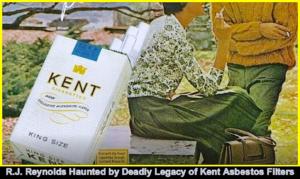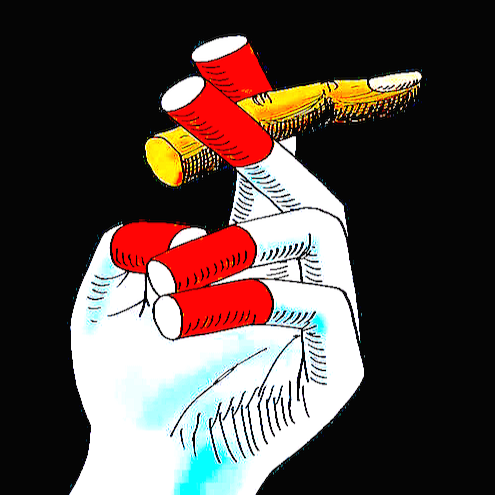Reynolds Pay $3.5 million – Asbestos Cigarette Filters
20 October 2018
By Peter Hayes
R.J. Reynolds and a filter maker must pay $3.5 million to the estate of a Florida man, the state’s top court held this week. It’s a ruling that draws renewed attention to another, lesser known, deadly aspect of some cigarettes of the 1950s.
Kents were once touted as the safest smokes on the market because of their “extraordinary Micronite” filters which made them pure enough for even the “sensitive smoker” who worried about potential adverse health effects.
“The exclusive MICRONITE FILTER removes 7 times more nicotine and tars than any other leading cigarette filter” one ad in the now defunct New York Daily News touted. Don’t just try it once, the ad went on, try it for one or two weeks, to give yourself “time enough to allow your taste to adjust to so much less irritants in the smoke.”
.
Nowhere does the ad mention that “micronite” is crocidolite asbestos and that, from 1952 through 1956, the Lorillard Tobacco Co., now owned by R.J. Reynolds, used it as a filter in Kents.
.
That legacy showed itself again Oct. 15 when the Florida Supreme Court affirmed that the filters were one of several “causative factors” in Richard DeLisle’s development of mesothelioma.
The court upheld a jury’s finding that Lorillard and filter maker Hollingsworth & Vose each had to pay $1.76 million to DeLisle’s estate, which amounts to 44 percent of the total $8 million award in the case. The rest of the verdict is to be paid by industrial product makers who the jury found were other sources of his asbestos exposure.
The suit is one of several that, more than 60 years after the cigarette maker stopped using asbestos filters, is still playing out in federal and state courts.
As of the beginning of this year, a total of 29 cases involving micronite filters were scheduled for trial, according to financial statements of Reynolds American Inc., which acquired Lorillard in 2014.
This compares to 34 filter cases set for trial a year earlier.
The context of these numbers might become clearer soon. A Pennsylvania appeals court in August said Lorrilard must comply with a Philadelphia-area judge’s order that the company produce a list of suits it compiled in 2011.
That list is to include not only Kent smokers who used the micronite filters, but also another category of plaintiffs—the workers at the plants that once produced the asbestos filters. The list was compiled during the cigarette maker’s prior defense of a Kentucky plant worker’s suit.
Whatever that list reveals, it’s unlikely the number of cases headed to trial will go up much in the years ahead because the number of people still alive who smoked with the filters, and worked with them, is dwindling, attorneys who have litigated the suits say.
Other Verdicts
But the trials will continue because Lorillard has been fighting the micronite-filter cases as hard as it has been fighting the many regular cancer-causing tobacco suits pending against it.
Not only that, the company has won many cases, like this one in 2010, where it successfully argued the smokers’ asbestos-related diseases came from any of a number of other potential sources.
The Florida verdict, however, is far from the first inplaintiffs’ favor. Back in 1997, a California appeals court uphelda $1.3 million compensatory verdict and a $700,000 punitive award against Lorillard and H&V.
That award went to a clinical psychologist who a jury found switched to Kents because he thought the filters were safer than what he had smoked. He died in 1996 of mesothelioma.
And, in2011, a San Francisco jury awarded nearly $1.4 million to Donat Lenney, another former Kent smoker.
Lenney’s attorney said something that helped his client with that award was the absence of anything else that could have contributed to his client’s asbestos disease.
“In the case we tried, we didn’t have other defendants,” said attorney William Levin with Levin Simes LLP in San Francisco.
He said Lenney was a bit of an unusual plaintiff in that, unlike many other former military members and industrial workers who have sued, Lenney was a white-collar worker, an insurance agent whose only asbestos exposure during his life came from Kents.
That helped sway the jurors, Levin said, to see past Lorrilard’s arguments that the filters must not have been too bad. After all, it said, they were once even used in hospitals and, like the newsapaper ad from 1952 touted, even “to purify the air in atomic energy plants.”
A Lorillard spokesman declined Bloomberg Law’s request
for comment about this story Oct. 19.
Reproduced by:
See also ⇒HERE ⇐
The Surgeon General C. Everett Koop MD (USPHS) stated that radioactivity, rather than tar, accounts for at least 90% of all smoking-related lung cancers.
The Center for Disease Control stated“Americans are exposed to far more radiation from tobacco smoke than from any other source.”
Sugar & Fluoride Content Of Various Forms Of Tobacco





